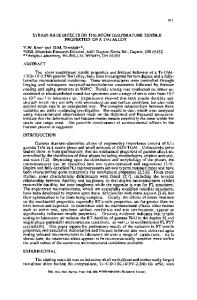The strain rate and temperature effects on the static and dynamic properties of S2 glass/epoxy composites
- PDF / 2,760,579 Bytes
- 15 Pages / 595.276 x 790.866 pts Page_size
- 85 Downloads / 291 Views
The strain rate and temperature effects on the static and dynamic properties of S2 glass/epoxy composites Zafer Kaya1 · Hüseyin Ersen Balcioglu2 · Halit Gün2 Received: 7 January 2020 / Accepted: 26 July 2020 © Springer-Verlag GmbH Germany, part of Springer Nature 2020
Abstract The environmental conditions, the loads during service, the resistance of the materials against these loads and also the price/ benefit ratios affect the choice of materials. S2 glass-reinforced polymer composites are among the most widely used composite structures, especially when high strength and low cost are required. Polymer matrix composite materials show ductile damage at high temperatures and brittle damage mechanism at low temperatures. Therefore, environmental temperature is a parameter that restricts the use of polymer matrix composites. In this study, mechanical characterization of S2 glass/ epoxy-laminated composites was investigated at different environment temperature (− 20 °C, 0 °C, 20 °C, and 80 °C) and different strain rate (8.3 × 10–3, 8.3 × 10–4, and 8.3 × 10–5 s−1). In this context, quasi-static tensile, and compressive tests were performed. In addition, S2 glass/epoxy composites were subjected to dynamic mechanical analysis (DMA) under variable temperature and load to examine their viscoelastic behavior. Another test to better characterize the composite structure of the S2 glass/epoxy material was thermogravimetric analysis (TGA). Test results showed that the S2 glass/epoxy composite structure is sensitive to the variable deformation rate and variable ambient temperature. Keywords S2 glass/epoxy · Strain rate effect · Temperature effect · Mechanical properties · Dynamical mechanical analysis (DMA) · TGA analysis
1 Introduction The usage of high-performance fiber for structural applications that require high strength is increasing day by day. In this context, synthetic fiber types such as carbon, aramide, dyneema and glass fiber are the most frequently used. Glass fiber has been widely used in the manufacturing of polymerbased composite materials. Glass fibers have comparable mechanical properties to other sentetic fibers such as carbon and aramide fiber [1]. In addition, the mechanical and electrical properties of the composite material can be enhanced by reinforcing the nanoparticles into the glass fibers. In this respect, glass fiber is a type of fiber that is also suitable for nanocomposite applications [2–4]. Among glass fiber types, E-glass is the most commonly used type. However, when * Hüseyin Ersen Balcioglu [email protected] 1
Graduate School of Natural and Applied Sciences, Usak University, Uşak, Turkey
Department of Mechanical Engineering, Usak University, Uşak, Turkey
2
the strength and stiffness of the E-glass are not sufficient, S2-glass fiber that is higher durable than E glass is used. S2 glass fiber-reinforced polymer composites have ultimate properties such as corrosion resistant, fatigue, and impact strength when compared with traditional glass fiber. Modern developments in lan
Data Loading...











